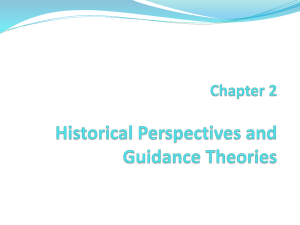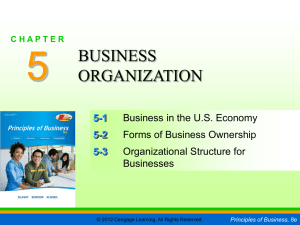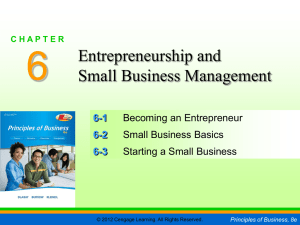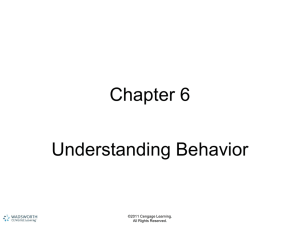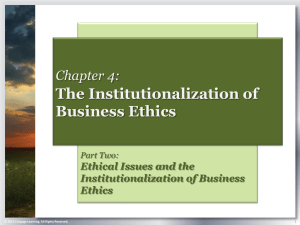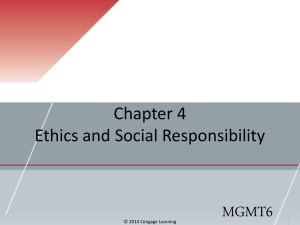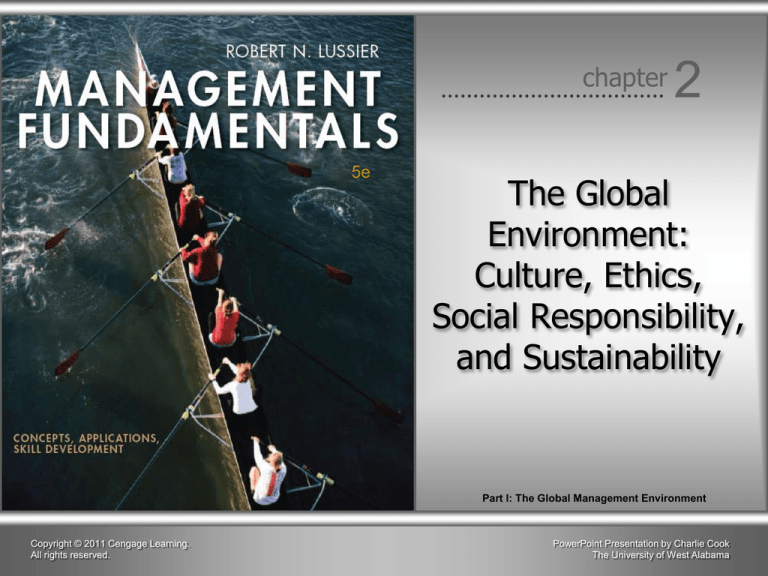
chapter
5e
2
The Global
Environment:
Culture, Ethics,
Social Responsibility,
and Sustainability
Part I: The Global Management Environment
Copyright © 2011 Cengage Learning.
All rights reserved.
PowerPoint Presentation by Charlie Cook
The University of West Alabama
Learning Outcomes
After studying this chapter, you should be able to:
1. Explain the five internal environmental factors.
2. List and explain the need for the two primary principles of total
quality management (TQM).
3. Describe the three levels of organizational culture and their
relationship to each other.
4. Describe how the nine external environmental factors—
customers, competition, suppliers, labor force, shareholders,
society, technology, the economy, and governments—can affect
the internal business environment.
5. Contrast the classification of businesses in the global village.
6. List the six activities that make a business a global one, in order
from lowest to highest cost and risk.
Copyright © 2011 Cengage Learning. All rights reserved.
2–2
Learning Outcomes (cont’d)
After studying this chapter, you should be able to:
7. Compare the three levels of moral development.
8. Explain the stakeholders’ approach to ethics.
9. Define the key terms listed at the end of this chapter.
Copyright © 2011 Cengage Learning. All rights reserved.
2–3
IDEAS ON MANAGEMENT at Amazon.com
1. Who is Amazon.com’s top manager, and what is its
mission, major resource, systems process, and structure?
2. What type of culture does Amazon.com have?
3. How does the external environment affect Amazon.com?
4. How is Amazon.com classified in the global village, and
how did it go global?
5. Is Amazon.com ethical, and does it have a code of ethics?
6. What types of things does Amazon.com do to be socially
responsible?
7. What types of things does Amazon.com do for
environmental sustainability?
Copyright © 2011 Cengage Learning. All rights reserved.
2–4
The Internal Environment
• Management and Culture
Organizational culture
The values, beliefs, and assumptions about appropriate
behavior that members of an organization share.
• Mission
A organization’s purpose or reason for being
Top management’s responsibility to develop a mission with
clear measurable objectives.
States the unique advantage the firm offers to customers that
differentiates it from its competitors.
Is relevant to all stakeholders’ interests.
Copyright © 2011 Cengage Learning. All rights reserved.
2–5
Exhibit 2–1
● Internal Environmental
Means and Ends
Copyright © 2011 Cengage Learning. All rights reserved.
2–6
The Internal Environment (cont’d)
•
Resources
Human resources
Physical resources
Financial resources
Informational resources
•
Systems Process
The method used to transform inputs into outputs
Process components
1.
2.
3.
4.
Inputs
Transformation
Outputs
Feedback
Copyright © 2011 Cengage Learning. All rights reserved.
2–7
Exhibit 2–2 ● The Systems Process
Copyright © 2011 Cengage Learning. All rights reserved.
2–8
The Internal Environment (cont’d)
• Quality
Comparing a product’s actual functioning to
requirements to determine value.
• Customer Value
The perceived benefits of a product, used by
customers to determine whether or not to buy a
product.
• Total Quality Management (TQM)
Focusing the organization on the customer to
continually improve product value.
Copyright © 2011 Cengage Learning. All rights reserved.
2–9
The Internal Environment (cont’d)
• Structure
The way in which resources are grouped to effectively
achieve the organization’s mission.
Organizations structure resources to transform inputs
into outputs.
All of an organization’s resources must be structured
effectively to achieve its mission.
Copyright © 2011 Cengage Learning. All rights reserved.
2–10
Exhibit 2–3 ● Components of the Internal Environment
Copyright © 2011 Cengage Learning. All rights reserved.
2–11
Copyright © 2011 Cengage Learning. All rights reserved.
2–12
Join the Discussion
Ethics & Social Responsibility
• Downsizing and Part-Time Workers
1. Is downsizing ethical and socially responsible?
2. Is using part-time employees rather than full-time
ones ethical and socially responsible?
3. Would you be willing to pay higher prices at stores,
such as Wal-Mart, so that more full-time workers
could replace part-time workers?
Copyright © 2011 Cengage Learning. All rights reserved.
2–13
Organizational Culture
• Learning the Organization’s Culture
Heroes
Stories
Slogans
Symbols
Ceremonies
• Three Levels of Culture
Level 1—Behavior (the visible level)
Level 2—Values and Beliefs (the invisible level)
Level 3—Assumptions are so deeply ingrained that
they are considered unquestionably true.
Copyright © 2011 Cengage Learning. All rights reserved.
2–14
Exhibit 2–4 ● Three Levels of Organizational Culture
Direction
of effect
Copyright © 2011 Cengage Learning. All rights reserved.
2–15
The Relationship between Strong and Weak
and Healthy and Unhealthy Cultures
Strong
Everyone works together with
similar behavior and values and
beliefs that help the organization
succeed at meeting its mission.
People work together, but the
behavior is based on poor
values and beliefs that hurt the
organization.
Unhealthy
Healthy
People don’t behave the same,
lack shared values and beliefs,
don’t stick together, and their
behaviors hurt the success of
the organization
People don’t behave the same,
lack shared values and beliefs, and
don’t stick together, but most work
toward meeting the mission.
Weak
Copyright © 2011 Cengage Learning. All rights reserved.
1–16
Organizational Culture (cont’d)
• Strong Cultures
Have employees who subconsciously know the
shared assumptions; consciously know the values
and beliefs; agree with the shared assumptions,
values, and beliefs, and behave as expected.
Advantage: benefit from easier communication and
cooperation; unity of direction; and consensus is easier to
reach
Disadvantage: threat of becoming stagnant
• Weak Cultures
Have employees who do not behave as expected
and do not agree with the shared values.
Copyright © 2011 Cengage Learning. All rights reserved.
2–17
Organizational Culture (cont’d)
• Healthy Cultures
Have positive values that are implemented that
contribute to success.
Have quality embedded in or supported by the firm’s
culture.
• Unhealthy Cultures
Have unhealthy factors that are negative and hinder
success, and can lead to failure.
Don’t support high quality and success.
Copyright © 2011 Cengage Learning. All rights reserved.
2–18
Copyright © 2011 Cengage Learning. All rights reserved.
2–19
Organizational Culture (cont’d)
• Managing, Changing, and Merging Cultures
Symbolic Leaders
Articulate a vision for the organization and reinforce the
culture through slogans, symbols, and ceremonies.
Facilitate cultural change and/or mergers.
• Learning Organizations
Have cultures that value sharing knowledge to adapt
to the changing environment and continuously
improve.
Strong leadership, team-based structure, employee
empowerment, open information, a participative strategy,
and a strong adaptive culture
Copyright © 2011 Cengage Learning. All rights reserved.
2–20
The External Environment: Task Factors
• Customers
Their needs decide what products businesses offer.
• Competition
Competitors’ business practices often have to be duplicated to
maintain customer value.
• Suppliers
Poor quality suppliers mean poor quality products.
• Labor Force/Unions
Quality labor is needed to produce quality products.
• Shareholders
The board of directors monitors management and provides
direction for the organization.
Copyright © 2011 Cengage Learning. All rights reserved.
2–21
The External Environment: General Factors
• Society
Businesses are pressured by societal forces to behave in an
acceptable manner.
• Technology
Firms must stay current on technology to stay competitive and
provide customer value.
• The Economy
Economic activity has both short and long-term effects on an
organization’s ability to provide customer value.
• Governments
Policies, rules, and regulations affect what, how much, and how
business is conducted.
Copyright © 2011 Cengage Learning. All rights reserved.
2–22
Copyright © 2011 Cengage Learning. All rights reserved.
2–23
Join the Discussion
Ethics & Social Responsibility
• Auto Fuel Efficiency
1. Are the automakers being ethical and socially
responsible by taking advantage of loopholes in the
law to classify one-half of their vehicles as light
trucks?
2. Should society be concerned about fuel efficiency?
Should people use fuel efficiency as a major criterion
when buying a car?
3. Should the government be involved in setting fuel
efficiency standards? If yes, should it change the
current standards? How?
Copyright © 2011 Cengage Learning. All rights reserved.
2–24
The External Environment (cont’d)
• Chaos and Interactive Management
Reactive managers
Make changes only when forced to by external factors.
Responsive managers
Try to adapt to the environment by predicting and preparing
for change before it occurs.
Interactive managers
Design a desirable future and invent ways of bringing it about
by trying to prevent, not prepare, for threats and to create,
not exploit, opportunities.
Copyright © 2011 Cengage Learning. All rights reserved.
2–25
Exhibit 2–5 ● The Organizational Environment
Copyright © 2011 Cengage Learning. All rights reserved.
2–26
The Global Environment
• The Global Village
Globalization is the number-one challenge of
business leaders in the 21st century.
Companies are conducting business worldwide
without boundaries as the world becomes smaller
through technology.
• Ethnocentrism and “Made in America”
Regarding one’s own ethnic group or culture as
superior to others (e.g., “Buy American”).
Copyright © 2011 Cengage Learning. All rights reserved.
2–27
Join the Discussion
Ethics & Social Responsibility
• Buy American
1. Is it ethical and socially responsible to ask people to
buy American?
2. Is it ethical and socially responsible to buy foreign
products?
Copyright © 2011 Cengage Learning. All rights reserved.
2–28
Foreign Trade
Currency
Exchange Rates
Trade
Agreements
Balance
of Trade
Protectionism
World Trade
Organization
(WTO)
Copyright © 2011 Cengage Learning. All rights reserved.
2–29
Exhibit 2–6 ● Exchange Rates
Suppose you are selling a product in China for 8,000 yuan. With an exchange
rate of 8 yuan to 1 dollar, you get $1,000 [8,000 (yuan selling price) divided by
8 (8 yuan = $1)] for each product you sell. Suppose that this price and
exchange rate give you a 25 percent profit margin. Now let’s see what happens
with the extreme fluctuations in exchange rates that sometimes occur:
• If the exchange rate becomes 6 yuan to 1 dollar, the yuan is strong
(and the dollar is weak). When you exchange the yuan for dollars,
you get $1,333.33 [8,000 (yuan selling price) divided by 6 (6 yuan =
$1)] for each product you sell.
• Now let’s make the dollar strong (and the yuan weak). If the
exchange rate goes to 10 yuan to the dollar, you get $800 [8,000
(yuan selling price) divided by 10 (10 yuan = $1)].
You can either change your yuan selling price to maintain your 25 percent
profit margin or make more or less based on the exchange rate. Now think
about the complexity of FedEx doing business in over 100 currencies.
Copyright © 2011 Cengage Learning. All rights reserved.
2–30
Global Trading Agreements
• World Trade Organization
Establishes and enforces world trade laws.
• Trade Alliances
European Union (EU)
Created a single market without national barriers to travel,
employment, investment, and trade.
Euro (€): single currency for the EU.
North American Free Trade Agreement (NAFTA)
United States, Canada, and Mexico
Association of Southeast Asian Nations (ASEAN)
Asia-Pacific Economic Cooperation (APEC)
Copyright © 2011 Cengage Learning. All rights reserved.
2–31
Exhibit 2–7 ● Trading Blocs
Copyright © 2011 Cengage Learning. All rights reserved.
2–32
Classifying Businesses in the Global Village
• Domestic Business
Conducts business only in its home country.
• International Business
Is based primarily in one country but transacts
business in other countries.
• Multinational Corporation (MNC) or Global
Business
Has significant operations in more than one country.
Copyright © 2011 Cengage Learning. All rights reserved.
2–33
Taking a Business Global
• Global Sourcing
The use of worldwide resources (outsourcing).
• Importing
A domestic firm buys products from foreign firms and
sells them in its home market.
• Exporting
A domestic firm sells its locally-made products to
foreign buyers in overseas markets.
Copyright © 2011 Cengage Learning. All rights reserved.
2–34
Exhibit 2–8 ● Taking a Business Global
Copyright © 2011 Cengage Learning. All rights reserved.
2–35
Taking a Business Global (cont’d)
• Licensing
One company allows another company to use its
assets (intellectual property) for a fee.
Brand name, trademark, technology, patent, and copyright
Franchising
For a fee and a percentage of the revenues, a franchiser
provides the franchisee with a combination of trademark,
equipment, materials, training, managerial guidelines,
consulting advice, and cooperative advertising.
Copyright © 2011 Cengage Learning. All rights reserved.
2–36
Taking a Business Global (cont’d)
• Contracting
A company has a foreign firm manufacture the goods
that it sells as its own.
• Joint Venture
An enterprise that is created when firms agree to
share in its ownership.
• Direct Investment
Investment that occurs when a company builds or
purchases operating facilities (subsidiaries) in a
foreign country.
Copyright © 2011 Cengage Learning. All rights reserved.
2–37
Copyright © 2011 Cengage Learning. All rights reserved.
2–38
Exhibit 2–9 ● Practices of Global Companies
Copyright © 2011 Cengage Learning. All rights reserved.
2–39
Copyright © 2011 Cengage Learning. All rights reserved.
2–40
Join the Discussion
Ethics & Social Responsibility
• File Sharing
1. Is it ethical and socially responsible for people to
download music, movies, or software for free, which
prevents recording, film, or software companies and
artists from getting any royalties?
2. Is it ethical and socially responsible for LimeWire and
others to give people the means to download music,
movies, or software for free?
Copyright © 2011 Cengage Learning. All rights reserved.
2–41
Join the Discussion
Ethics & Social Responsibility
• Bribes
1. Is it ethical and socially responsible to pay bribes?
2. Should the manager have paid the bribe to get the
phone installed?
Copyright © 2011 Cengage Learning. All rights reserved.
2–42
Diversity
• To be successful in the global village, you need
to be sensitive to other cultures.
• GLOBE
Global Leadership and Organizational Behavior
Effectiveness (GLOBE) is an ongoing cross-cultural
investigation of leadership and national culture.
Copyright © 2011 Cengage Learning. All rights reserved.
2–43
Copyright © 2011 Cengage Learning. All rights reserved.
2–44
Exhibit 2–10 ● Global Leadership and Organizational Behavior
Effectiveness (GLOBE) Dimensions
Copyright © 2011 Cengage Learning. All rights reserved.
2–45
Business Ethics
• Ethics
The standards of right and wrong that influence
behavior.
Right behavior is considered ethical, and wrong behavior
is considered unethical.
Government laws and regulations are designed to
govern business behavior.
Ethics, however, go beyond legal requirements.
Ethical concepts are culturally-bound.
What is considered ethical in one country may be
unethical in another.
Copyright © 2011 Cengage Learning. All rights reserved.
2–46
Business Ethics (cont’d)
• Does Ethical Behavior Pay?
Research shows a positive relationship between
ethical behavior and leadership effectiveness.
Having strong ethics means having integrity, and people
trust others they believe have integrity.
Unethical behavior creates a negative image of big
business.
Mahatma Gandhi called business without morality a sin.
Copyright © 2011 Cengage Learning. All rights reserved.
2–47
Factors Affecting Ethical Behavior
Personality Traits
and Attitudes
Moral
Development
Ethical
Behavior
The Situation
Copyright © 2011 Cengage Learning. All rights reserved.
2–48
Levels of Moral Development
• Preconventional
Self-interest motivates behavior.
• Conventional
Behavior is motivated by the desire
to live up to others’ expectations.
• Postconventional
Behavior is motivated by universal
principles of right and wrong,
regardless of the expectations of
leaders or one’s group.
Copyright © 2011 Cengage Learning. All rights reserved.
2–49
Exhibit 2–11 ● Levels of Moral Development
Level
Copyright © 2011 Cengage Learning. All rights reserved.
2–50
How People Justify Unethical Behavior
• Moral Justification
The process of reinterpreting immoral behavior
in terms of a higher purpose.
Displacement of responsibility
Diffusion of responsibility
Advantageous comparison
Disregard or distortion of
consequences
Attribution of blame
Euphemistic labeling
Copyright © 2011 Cengage Learning. All rights reserved.
2–51
Simple Guides to Ethical Behavior
• Golden Rule
“Do unto others as you want them to do unto
you.”
• Four-Way Test
1. Is it the truth?
2. Is it fair to all concerned?
3. Will it build goodwill and better friendship?
4. Will it be beneficial to all concerned?
• Stakeholders’ Approach to Ethics
Creating a win-win situation for all stakeholders
so that everyone benefits from the decision.
Copyright © 2011 Cengage Learning. All rights reserved.
2–52
Managing Ethics
• Codes of Ethics
State importance of conducting business in an ethical
manner; provide guidelines for ethical behavior.
• Top Management Support and Example
Develop codes of ethics
Ensure that employees are instructed on what is and
what is not considered ethical behavior
Enforce ethical behavior
• Enforcing Ethical Behavior
Do not fail to punish unethical behavior.
Whistle-blowers should not suffer negative consequences.
Copyright © 2011 Cengage Learning. All rights reserved.
2–53
Social Responsibility
• Social Responsibility to Stakeholders
The conscious effort to try to create a win-win
situation for all external stakeholders, as well as
internal stakeholders.
• Does It Pay to Be Socially Responsible?
Social responsibility doesn’t guarantee or improve
profits, but scandals hurt corporate reputations.
• Social Audit
A measure of how well a firm’s social behavior helps
it achieve its social objectives.
Copyright © 2011 Cengage Learning. All rights reserved.
2–54
Join the Discussion
Ethics & Social Responsibility
• TV Sex, Profanity, and Violence
1. How do TV and movies influence societal values? (Consider
that many children watch as many as five hours of TV per day.)
2. Do TV shows and movies that include sex and violence reflect
current religious and societal values?
3. Is it ethical and socially responsible to air TV shows with sexual
content, profanity, and violence during hours when children are
watching?
4. Is it ethical and socially responsible to portray women as sex
objects?
5. Should the FCC regulate television, and if yes, how far should it
go? Should it make networks tone down the sex and violence,
or take shows off the air?
Copyright © 2011 Cengage Learning. All rights reserved.
2–55
Sustainability
• Sustainability
Meeting the needs of the present world without
compromising the ability of the future generations to
meet their own needs.
• Sustainability Practices in “Green” Companies
Conserving inputs and energy resources to create
long-term environmentally sustainable products.
• Organizations for Sustainable Development
World Business Council for Sustainable Development
International Institute for Sustainable Development
Copyright © 2011 Cengage Learning. All rights reserved.
1–56
KEY TERMS
•
•
•
•
•
•
•
•
•
•
•
•
•
customer value
direct investment
ethics
ethnocentrism
external environment
global sourcing
global village
internal environment
international business
joint venture
learning organization
levels of culture
mission
Copyright © 2011 Cengage Learning. All rights reserved.
• multinational corporation
(MNC)
• organizational culture
• quality
• social responsibility
• stakeholders
• stakeholders’ approach
to ethics
• symbolic leaders
• systems process
• total quality
management (TQM)
2–57

